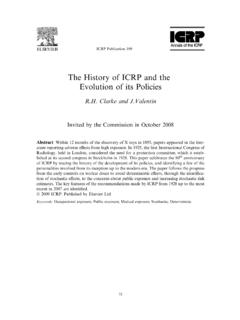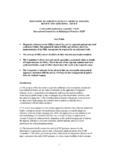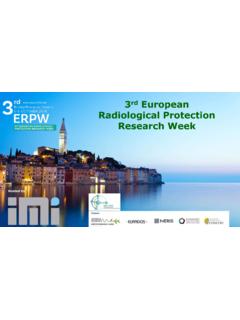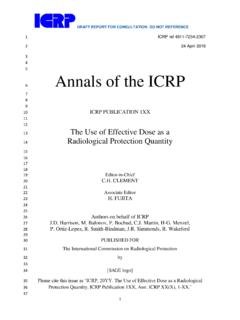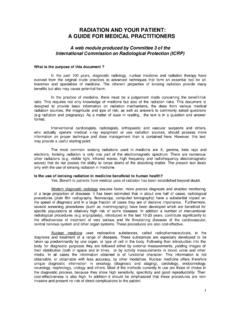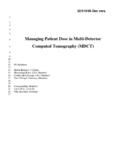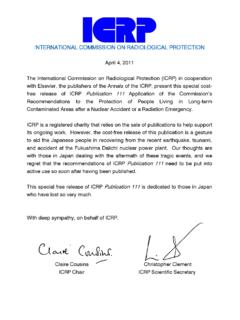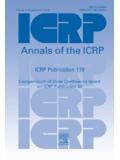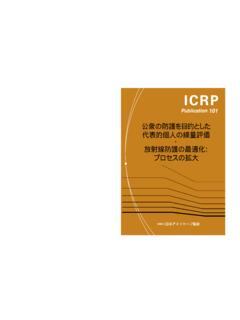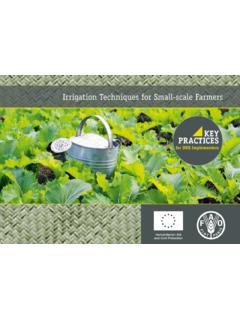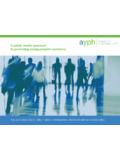Transcription of Justification of medical exposures - ICRP
1 Justification of medical exposuresReferral criteria and clinical decision supportDr Maria del Rosario P rezPublic Health and Environment2ndInternational Symposium on the System of Radiological Protection, October 2013, Abu Dhabi , UAEWhat do we need from ICRP in medicine?2|International days of medical physicists, radiologists, radiographers coming days of medical physicists, radiologists, radiographers coming |A bit of history-some relevant dates A bit of history-some relevant dates l7th November1867: Maria Sk odowskawas born in Poland. She and her husband were awarded the Nobel Prize for Physics in 1903, for their studies on radioactivity. l7th of November 1911: Marie Curiewas awarded the Nobel Prize for Chemistry in recognition of her discovery of the chemical elements radium and November 1895:Wilhelm Conrad R ntgendiscovered a new kind of ray that he temporarily called "X-rays".4|Use of radiation for medical imagingUse of radiation for medical imaginglFollowing the discovery of X-rays, the use of radiation for diagnosis and treatment for human diseases expanded worldwide.
2 LBenefits gained recognition, and it represents today the major contributor to human exposure to artificial technology makes new applications safer. However, inappropriate or incorrect use can lead to unnecessary or unintended radiation exposures and |International Conference on RP in Medicine Organized by the IAEA, cosponsored by WHO, hosted by the Government of Germany. > 500 participants from around 80 countries and 16 organizations reviewed advances, challenges and opportunities. Main outcome: Bonn Call for Actionto improve RP in health care in the next decade. 6|Bonn Call for Action implementation of Justification of implementation of optimization of protection and manufacturers contribution to radiation RP education and training of health & promoting a strategic research agenda for RP in data collection on radiation exposures of patients and primary prevention of incidents and adverse radiation safety culture in health an improved radiation the implementation of safety requirements (BSS) |Bonn Call for Action implementation of Justification of implementation of optimization of protection and manufacturers contribution to radiation RP education and training of health & promoting a strategic research agenda for RP in data collection on radiation exposures of patients and primary prevention of incidents and adverse radiation safety culture in health an improved radiation the implementation of safety requirements (BSS) |Action 1.
3 enhance the implementation of the principle of justificationAction 1: enhance the implementation of the principle of justificationa)Introduce and apply the 3A s (awareness, appropriateness and audit), which are seen as tools that are likely to facilitate and enhance Justification in practice;b)Developharmonized evidence-based criteria to strengthen the appropriateness of clinical imaging, including diagnostic nuclear medicine and non-ionizing radiation procedures, and involve all stakeholders in this development;c)Implementclinical imaging referral guidelinesglobally, keeping local and regional variations in mind, and ensure regular updating, sustainability and availability of these guidelines;d)Strengthen the application of clinical audit in relation to Justification , ensuring that Justification becomes an effective, transparent and accountable part of normal radiological practice;e)Introduce information technology solutions, such as decision support tools in clinical imaging, and ensure that these are available and freely accessible at the point-of-care;f)Further develop criteria for Justification of health screening programmesfor asymptomatic populations( mammography screening) and for medical imaging of asymptomatic individualswho are not participating in approved health screening |Appropriateness in imaging: "Best Test First !
4 "Appropriateness in imaging: "Best Test First !"lWhen choosing a procedure utilizing ionizing radiation, the benefit/risk balancemust be carefully considered. lEven if benefits outweigh risks, there is unnecessaryuse of radiation when clinical evaluation or other imaging modalities could provide an accurate diagnosis ( US, MRI). lCost, local expertise, available resources, accessibility and patient values have to be considered in addition to efficacy. 10|lThe benefit outweighs the risk when the procedure is: appropriately prescribed properly performed. lThis is not the case if there is no clinical indication or the radiation dose is higher than necessary for the clinical purpose ( adult protocols used for imaging children) Do the right procedure ! Do do the procedure right !Reducing unnecessary radiation exposuresReducing unnecessary radiation exposuresJUSTIFICATIONOPTIMIZATION11|Lin king Justification & optimization Gate keeperBookingRegistrationPreparationExam inationReport TranscriptionValidationDeliveryQA/ Error reductionJustificationOptimizationPatien t journey(adapted from Dr.)
5 L. Lau IRQN/ISR)12|Referral guidelines: what are we talking about?Referral guidelines: what are we talking about?lEvidence based medicine integrates the best available clinical evidence from systematic research with the individual clinical expertise, to consider what may be applicable to or appropriate for an individual patient. lReferral guidelines (RGs) are decision-support toolssystematically developed to assist practitioners on decision about appropriate healthcare for specific |Referral Guidelines for medical ImagingReferral Guidelines for medical ImaginglA medical imaging examination is useful if its outcome either positive or negative influences management of the patient or strengthens confidence in the guidelines for medical imagingprovide physicians with information on which procedure is most likely to yield the most informative results, and whether another modality is equally or more effective, and therefore more appropriate.
6 LThese guidelines support the practice of evidence-based medicine and form a foundation to guideappropriateness in prescribing diagnostic imaging |ACR -Abdominal pain in children15|RCR: Abdominal pain in children16|Some reasons for unnecessary proceduresSome reasons for unnecessary procedureslLack of awareness about radiation doses & associated riskslInsufficient access to referral guidelines at the point of carelLow confidence in clinical diagnosis & over-reliance on imaging lConsumer demand (patient's and/or family's expectations)lSelf-referral, opportunistic screening, defensive medicinelPressure from other specialists "What does the CT shows?" lPressure from promotion and marketing of sophisticated technologylLack of dialogue/consultation between referrers and radiologists lNon-availability of other appropriate imaging modality ( US, MRI)lFragmentation vs. continuity of health care: unnecessarily repeated examinations 17|Defensive medicine is a strong driving forceDefensive medicine is a strong driving forceConcerns about malpractice litigation".
7 Physicians may respond to the perceived threat of litigation by ordering more referrals and more tests, some of which may be recommended by clinical guidelines and beneficial, but others might be wasteful and harmful"18|Integration of decision support systemsIntegration of decision support systemslReferral guidelines are decision support tools ( advisory rather than compulsory). However, a physician should have good reasons to deviate from the recommendations. lLinkage with voluntary use has limited success compared with integration of guidelines into electronic Order ("request") Entry (COE) systems facilitate the integration of decision support systems into the daily workflow, with provision of interactive reminders. lAt the time of entry into the COE referring doctors receive feedback on the degree of appropriateness of their choices relative to the referral guidelines (it allows for warnings). 19|Clinical decision support: bringing the guidelines to the point of careClinical decision support: bringing the guidelines to the point of carelInsufficient access at the point of care is a major cause of lack of adherence of physicians to referral guidelines (RGs).
8 LBulky, paper manuals are likely to sit on a shelf and go unused. Physicians need timely and easy access to user-friendly evidence-based RGs that are relevant to their decision support: implementation of referral guidelines depends not only on the content, but also on the format and |Criteria for media selectionCriteria for media selectionlEase of preparation/productionlUser acceptancelCostlFlexibilitylConveniencel DurabilitylMode of distributionlLocal resourcesChoice of media depends on users needs and setting conditions 21|Effect of COE with integrated decision support: reduced the growth rate of CT procedures Effect of COE with integrated decision support: reduced the growth rate of CT procedures Sistromet al. Effect of Computerized Order Entry with Integrated Decision Support on the Growth of Outpatient Procedure Volumes: Seven-year Time Series Analysis. Radiology, 2009. 251, 147-155. |Involvement of stakeholders and end users Involvement of stakeholders and end users lBy participation in the process they share ownershipof solutions and outcomes and become contributes to improve implementation of appropriateness criteria/referral to identify suitable mechanisms for participation at different stages development/adaptation of guidelines; development of guidance/strategies for implementation, pilot testing, monitoring use, evaluation of the approaches need to be regionally/locally , Korea, October 2013 Potential stakeholdersPotential stakeholdersReferrersReferral guidelines for medical imagingGPs, family doctors, paediatricians, emergency doctors, other specialists Professional societiesMedical defence organizationsInternational agencies Manufacturers Student organizationsTrade unionsMedia?
9 , governmental bodies (ministries of education) Universities, academic institutionsScientific bodies24|Stakeholders' mapping Stakeholders' mapping Active ResistersBlockersActive SupportersChampionsPassive ResistersAvoidersPassive SupportersSilent BoostersEnergy investedCommon interestNecessary exercise for setting priorities and developing targeted engagement strategies 25|Stakeholders engagement (I)Stakeholders engagement (I)lPartnership as a key theme healthcare professionals, patients, policy of health care professionals in radiation protection should go beyond the radiological medical can significantly contribute to the implementation of radiation protection principles in health care:GPs/family doctors, pediatricians, emergency doctors, dentists, medical and dental school |Stakeholders engagement (II)Stakeholders engagement (II)lPartnership as a key theme healthcare professionals, patients, policy patient as the constant in the continuum of care a repository of information and valuable resource for improving health care healthcare is a goal of both patients and networks ( Patients for Patient Safety /PFPS) are collaborative partners and are therefore key partners to improve radiation safety culture in health |Stakeholders' engagement is crucial.
10 Patients' associations are "key" stakeholders28|Need to improve communication between doctors and patients, need to use other communication resourcesNeed to improve communication between doctors and patients, need to use other communication resourceslIn the past doctors were trusted and respected as the source of medical advice (and patients followed their advice).lCommunication/dialogue between doctors and patients went downwards, internet is a major source of information and even advice (and many patients don't follow doctors' advice).29|To improve risk/benefit dialogueTo improve risk/benefit dialogueCommunicating Radiation Risks in Paediatric ImagingCommunication tool for health care providersGlobal Initiative on Radiation Safety in Health Care SettingsTo support radiation risk communication (guidelines and tools for capacity building, information products, check-lists)Communication toolkit30|Bonn Call for Action implementation of Justification of implementation of optimization of protection and manufacturers contribution to radiation RP education and training of health & promoting a strategic research agenda for RP in data collection on radiation exposures of patients and primary prevention of incidents and adverse radiation safety culture in health an improved radiation the implementation of BSS |International Radiation Basic Safety Standards (BSS) The BSS are the benchmark(*)for radiation safety requirements worldwide.
